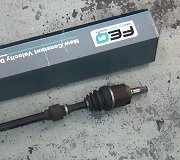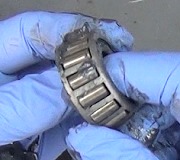I'm not convinced you've found the problem. 1/8" of slop is not out of the ordinary. You would also see metal shavings and the stub shaft would be chewed up. After rereading my first reply, I see I wasn't clear on the wear I was refering to with the inner cv joint. The fact that the joint moves up and down 1/8" is irelevent because it would only cause a vibration in the driveline at very high rpm. The vibration would not be transferred to the steeing wheel. Plus, it's not spinning near fast enough to be noticeable, and you certainly wouldn't get a noticeable vibration at low speeds.
The wear I was referring to has to do with the roller surfaces inside the inner cv joint housings. I ran into about two dozen of these in one two-year period at the dealership, but these were all on minivans. The same joints were used on cars, but I don't recall ever finding a bad housing on a car. The symptoms you described fit perfectly though.
There was not much the vehicles with bad joints had in common. The model years and mileages varied widely. Only the side was fairly consistant. The problem was almost always on the right side. The problem was so common for a while, I tore my own van apart for the same reason, totally overlooking a broken tire belt. And I'm supposed to be the expert! Eventually I developed a procedure for diagnosing this problem. Remember, this applies to minivans. The only difference with your Intrepid is you are supposed to replace the axle nut every time it is loosened.
First of all, the weight of the car must be off the wheel bearing before the axle nut is loosened. The nut and outer cv joint housing hold the bearing together. The bearing will become noisy if the car's weight is on it when it's not held tightly together.
With the nut removed, use your thumb to push the outer joint toward the transmission. It should be hard to move, but will go about an inch, then spring back under heavy spring pressure. If it does not spring back, the inner joint's spring is broken. Replacement springs with cups on the end are avaiable from the dealer. Note than the outer joint on Intrepids is usually stuck in the bearing so you might have to check the spring when the joint is disconnected from the bearing.
Usually if the spring was broken, the inner housing was also worn, but with most worn housings, the spring was only broken about 10 percent of the time. The inner joint must be disassembled to inspect it. Watch out when pulling the rollers out. Some joint manufacturers don't include a clip on the ends of the tripod to hold the rollers on. If they fall off, you'll be chasing needle bearings around on the floor.
Wipe the grease out of the housing, then run your finger along the six polished rolling surfaces. If you can feel the slightest irregularity, you REALLY have junk. Next, when those surfaces are perfectly clean, shine a light into the housing and look at the reflections. If you see any waviness, similar to looking at the body of a car reflecting in the ground at a car show, the housing must be replaced. When the shaft rotates, the rollers run back and forth on these surfaces to let the shaft change angles and length. Under the load of accelerating, the rollers will bind in the low spots and won't roll freely. As a result, the shaft pushes out against the outer joint, bearing and hub, steering knuckle, lower control arm and steering linkage. Pushing on the steering linkage is why you feel the steering wheel shimmy. Another clue of this problem is the binding and shimmying stop when cruising or coasting. If you still feel the shimmy when coasting up to a stop sign, recheck for broken tire belts. Switch the front and rear tires and do another test drive.
Caradiodoc
Saturday, February 27th, 2010 AT 4:01 AM




